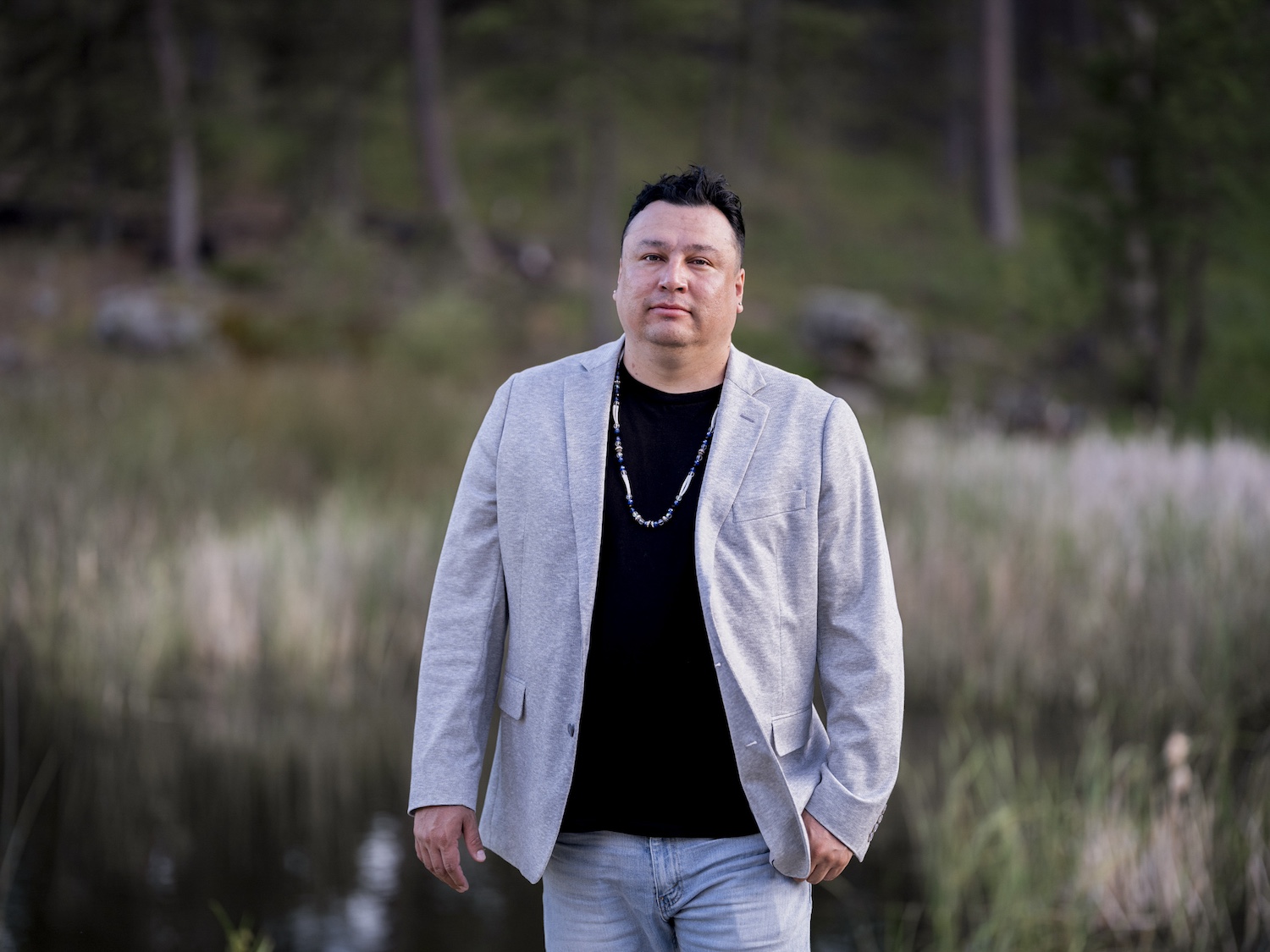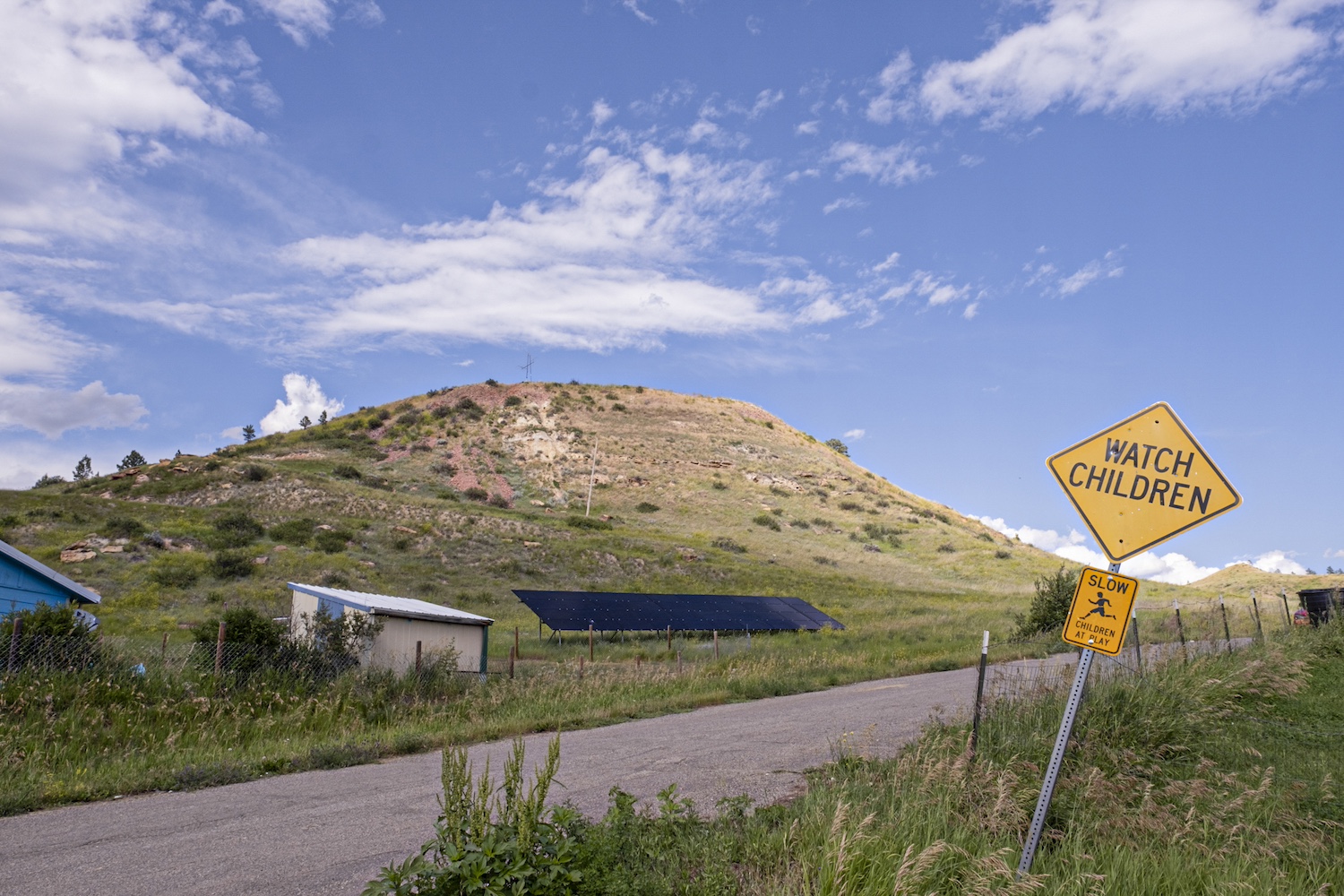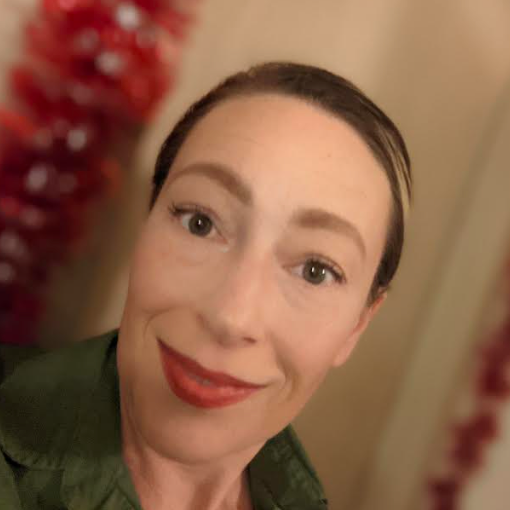
Cody Two Bears (center), founder of the energy sovereignty nonprofit Indigenized Energy, smiles while leaning on a solar panel array. (Image: Nina Robinson)
At the end of 2024, Dream.Org launched the Make It Real photojournalism series to highlight the challenges and triumphs of those fighting for a more sustainable and equitable future in the United States. We're collaborating on a series of TriplePundit articles to share these stories. This is one of several features centered on the climate leaders empowering Native communities to reclaim energy sovereignty while building resilience.
Cody Two Bears knows a thing or two about coalitions. From fighting against the Dakota Access Pipeline in the mid-2010s to founding the nonprofit Indigenized Energy, he’s experienced the power of tribal nations coming together. With renewable energy, he pivoted that power from fighting against fossil fuels to fighting for energy sovereignty.
“I wanted to change to a new way for Native communities that would really allow us to stop playing defense so much, but allow us to play offense,” said Two Bears, who was showcased in Dream.Org’s Make it Real photojournalism campaign featuring U.S. climate leaders. “We've always protested, protested, protested and been against something. But now with this new initiative, Indigenized Energy, it gives us the opportunity to fight for something for native tribes.”
Two Bears, who is an enrolled member of the Standing Rock Sioux Tribe, was the youngest leader to ever be elected to its tribal council in 2013. A year later, developers proposed plans for Dakota Access, a more than 1,000-mile pipeline meant to carry crude oil from the Bakken oilfields of northwest North Dakota to a hub in Patoka, Illinois. The pipeline’s planned path came within half a mile of the Standing Rock Sioux reservation and crossed over the Missouri River, which supplies drinking water to millions of people, including those in the tribe.
Tribal opposition to DAPL began almost immediately, but it wasn’t until 2016 that those protests garnered global attention. The Oceti Sakowin protest camp brought tribal members and allies from around the U.S. to Stand with Standing Rock. The water protectors’ chants of “Mni Wiconi” (“Water is life”) ushered the issue home for millions around the world, even as the protesters faced abuse from police and the pipeline company’s private security forces. The movement became known as NoDAPL.
“What NoDAPL taught a lot of tribal nations is that when you come together, you start to see amazing things happen, because it's really hard for one tribe to fight something alone and allow their voices to be heard,” Two Bears said. “Why NoDAPL was so successful is when you have 350-plus nations come together … your voices are absolutely going to be heard.”

The protests did a formidable job of slowing DAPL, but it eventually came online in 2017. It has leaked at least five times since then, according to the Sierra Club, and though none of the leaks contaminated a water source, tribal leaders say it’s only a matter of time. The Standing Rock Sioux filed a federal lawsuit last October asking for the pipeline’s use to be halted.
Beyond defending tribal sovereignty in the face of developments like DAPL, Two Bears sees energy sovereignty and independence as the future for his people. “Like food sovereignty, traditional medicines, culture and language, energy to Indigenous and native people in this country now is one of those main pillars that we need to focus on moving forward,” he said.
That’s why he launched Indigenized Energy, which aims to develop energy sovereignty on tribal lands via renewable energy. In 2019, the nonprofit debuted a 300-kilowatt solar farm in Two Bears’ hometown of Cannon Ball, North Dakota, just three miles from the Dakota Access Pipeline. To this day, it’s the largest solar farm in the state, he said.
“I told myself, if we can see solar there, we can do it anywhere,” he said. When it comes to fossil fuel development, North Dakota is second only to Texas. Unsurprisingly, renewable energy faces strong opposition in the state. But Two Bears insists “energy in itself should never be political.”
“What I mean by that is renewable and especially solar energy is the cheapest form of energy anywhere in the world, right? And it makes sense in communities like where I come from because it's less to maintain, but it provides energy and savings within your home,” he said.
Two Bears has learned to work around the politicization of renewable energy and the climate crisis in Republican states, shifting his focus to economics.

By 2020, word of Two Bears’ work spread to other tribal nations, which prompted him to expand Indigenized Energy in the interest of sharing his knowledge and supporting other tribes. The organization went on to form the Northern Plains Tribal Coalition along with 14 tribal nations.
It’s a “first of its kind coalition of tribes within the Northern Plains — which we’re really proud of — that focuses on energy and energy sovereignty,” Two Bears said.
The coalition was recently awarded a grant of almost $136 million from the U.S. Environmental Protection Agency Solar For All program that will pay for solar array and battery pack installation on over 200 homes for each participating tribe, he said. In a place where households receive monthly electricity bills upwards of $800 to $1,000 during the winter, the impact will be monumental.
“My community of Cannon Ball and Standing Rock … we paid the highest utility rates at 13, almost 14 cents per kilowatt-hour,” Two Bears said. “You go seven miles off our reservation — the same utility line, same rural area, same small communities, just off the reservation — they pay seven or eight cents.”
It was -17 degrees Fahrenheit the night before TriplePundit spoke with Two Bears. Sub-zero temperatures, coupled with poorly insulated housing, only exacerbate the community’s high energy prices. And when people can’t pay, their utilities are shut off. The result is deadly, with people passing away in their homes from the extreme cold, he said.
Two Bears sees energy independence as a way to save lives today and safeguard his community into the future, combining Western science and technology with Indigenous values and ways of life. A just energy transition includes Indigenous people on the frontlines as caretakers of the land, he said. And he’s determined to ensure they don’t get left behind or forgotten like they were after showing the original colonialists how to survive on the land.
Though treaties relegated tribal nations to some of the worst lands, he pointed to that same land as being some of the most unspoiled in the country. By embracing some Western technology, he sees an opportunity for Indigenous knowledge and values to teach people how to live in a way that respects the land and water again.
“We want to be able to create a new way that does honor the old ways of how we used to live within Indigenous communities, but also share that with the rest of the world,” Two Bears said. Referring to the effects of the climate crisis people are witnessing in real-time, he added: “I really feel that understanding what we're doing here at Indigenized Energy can help a lot of those non-tribal communities or non-Indigenous communities learn about how to do things in a good way moving forward.”

Riya Anne Polcastro is an author, photographer and adventurer based out of Baja California Sur, México. She enjoys writing just about anything, from gritty fiction to business and environmental issues. She is especially interested in how sustainability can be harnessed to encourage economic and environmental equity between the Global South and North. One day she hopes to travel the world with nothing but a backpack and her trusty laptop.














